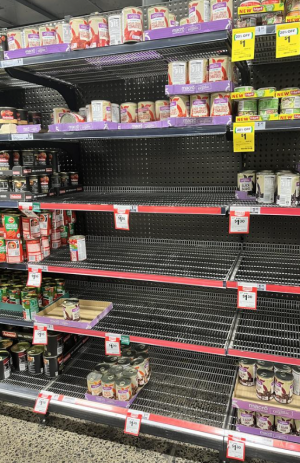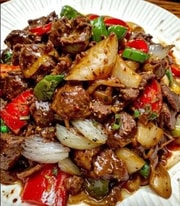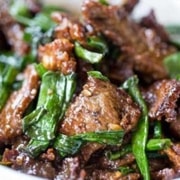If you can’t find chickpeas in your local supermarket, you’re not alone — experts say the global shortage won’t be easing this year
Keep stopping by supermarkets in the hopes of restocking your chickpea supply? You must have seen aisles stripped bare of the canned goods.
Sadly, you probably won’t see many of them in the foreseeable future.
Stores like Woolworths are blaming supply chain delays for the lack of chickpeas on their shelves.
Speaking with news.com.au, a Woolworths spokesperson said: ‘We’re working with suppliers to maintain regular and consistent deliveries of stock to supermarkets.’
Woolworths reassured customers that stocks would be replenished in a week. Furthermore, they encouraged Aussies to shop as they normally would without hoarding supplies.
However, global reports are not as encouraging.
Data from the Dubai-based non-profit Global Pulse Confederation (GPC), which represents various sectors in the pulse industry, shows that chickpea production worldwide will be down by as much as 20 per cent this year.
The cause? GPC points out two reasons: one is the ongoing war in Ukraine. The other is the persisting harsh weather conditions globally.
Russia, a major exporter of the legume, accounts for about 25 per cent of the global supply. However, the country’s invasion of neighbouring Ukraine has led to sanctions by the EU that have affected production.
Lara Gilmour from the GPC commented on Russia’s situation: ‘They are producing chickpeas this year, but with the sanctions and with the container issues, they can’t ship or sell their products, and if they do, it’ll be a very negligible amount.’
The same is the case for Ukraine, another chickpea producer responsible for about five per cent of the global supply. ‘They haven’t seeded, we don’t believe, enough to make a dent on global supply,’ Gilmour said.
Meanwhile, other major exporters have also faced issues of their own.
Extreme weather conditions in the United States — ranked as the fourth top producer of legumes worldwide — have impacted its chickpea production. Drought on the country’s west coast forced farmers to produce more corn and wheat instead of the less profitable chickpeas.
Exports from Australia, another major chickpea producer, have increased in the past months. However, the local industry has struggled to keep up with the growing global demand, especially after recent flooding affected crops.
The unfortunate result of the shortage is the increased price of the household staple. North American and European consumers are already feeling the impact.
Things might get better in the next year, but prices won’t return to pre-pandemic levels, according to DHL CEO of Global Forwarding, Freight Tim Scharwath.
‘I don’t think we’re going back to this overcapacity situation where rates were very low. Infrastructure, especially in the US, isn’t going to get better overnight because infrastructure developments take a long time.’
Knowing all this means we’ll probably have to give up hummus in the meantime here at SDC.
Have you found any alternatives to the protein-rich legume? Share it with other members through the comments below!
Sadly, you probably won’t see many of them in the foreseeable future.
Stores like Woolworths are blaming supply chain delays for the lack of chickpeas on their shelves.
Speaking with news.com.au, a Woolworths spokesperson said: ‘We’re working with suppliers to maintain regular and consistent deliveries of stock to supermarkets.’
Woolworths reassured customers that stocks would be replenished in a week. Furthermore, they encouraged Aussies to shop as they normally would without hoarding supplies.
However, global reports are not as encouraging.
Data from the Dubai-based non-profit Global Pulse Confederation (GPC), which represents various sectors in the pulse industry, shows that chickpea production worldwide will be down by as much as 20 per cent this year.
The cause? GPC points out two reasons: one is the ongoing war in Ukraine. The other is the persisting harsh weather conditions globally.
Russia, a major exporter of the legume, accounts for about 25 per cent of the global supply. However, the country’s invasion of neighbouring Ukraine has led to sanctions by the EU that have affected production.
Lara Gilmour from the GPC commented on Russia’s situation: ‘They are producing chickpeas this year, but with the sanctions and with the container issues, they can’t ship or sell their products, and if they do, it’ll be a very negligible amount.’
The same is the case for Ukraine, another chickpea producer responsible for about five per cent of the global supply. ‘They haven’t seeded, we don’t believe, enough to make a dent on global supply,’ Gilmour said.
Meanwhile, other major exporters have also faced issues of their own.
Extreme weather conditions in the United States — ranked as the fourth top producer of legumes worldwide — have impacted its chickpea production. Drought on the country’s west coast forced farmers to produce more corn and wheat instead of the less profitable chickpeas.
Exports from Australia, another major chickpea producer, have increased in the past months. However, the local industry has struggled to keep up with the growing global demand, especially after recent flooding affected crops.
The unfortunate result of the shortage is the increased price of the household staple. North American and European consumers are already feeling the impact.
Things might get better in the next year, but prices won’t return to pre-pandemic levels, according to DHL CEO of Global Forwarding, Freight Tim Scharwath.
‘I don’t think we’re going back to this overcapacity situation where rates were very low. Infrastructure, especially in the US, isn’t going to get better overnight because infrastructure developments take a long time.’
Knowing all this means we’ll probably have to give up hummus in the meantime here at SDC.
Have you found any alternatives to the protein-rich legume? Share it with other members through the comments below!








